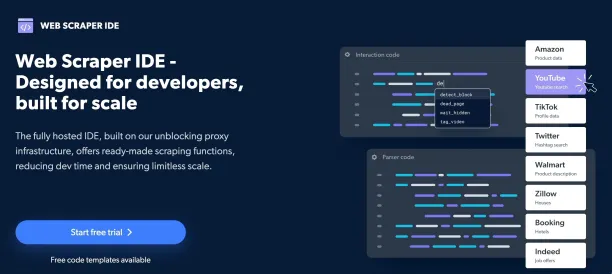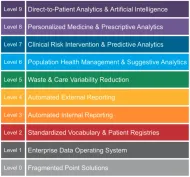Top 5 Web Scraping Analytics Use Cases with Examples in 2024
Most web scraping use cases falls under data analytics and data-driven decision making. However, it is not always clear to business leaders how pages of unstructured web data would feed into their data analysis dashboards and models.
In this article, we will dive into specific web scraping analytics use cases with examples.
1. Dynamic Pricing
Dynamic pricing is tracking your competitors’ prices online and updating your prices to stay competitive. In our in-depth guide about the subject, we gave examples of industries that dynamic pricing has been widely used. Especially for products and services that have high seasonality, such as flight ticket prices during holidays or technology products before special days, businesses need to track prices dynamically from a dashboard and calculate their price range automatically with most up-to-date data. Without real-time analytics, it is likely to stay behind the competitor’s price and lose big volumes of online shoppers during high seasons.
Web scraping for price information, namely “price scraping”, allows businesses to collect price information from thousands of e-commerce websites quickly. Web scraping can be preferred to alternative data pulling methods, such as APIs, because price scraping algorithms can be modified across different e-commerce websites by leveraging common design elements of these websites. For any website that doesn’t support APIs, web scraping tools will be the only viable solution, and once it is developed, it can be modified and reapplied for multiple websites rather than building a separate data pipeline with APIs.
2. MAP Compliance
Another use case of price scraping is MAP (Minimum Advertised Price) tracking. Manufacturers and brands that sell through online retailers share minimum price policies with their partners to ensure competitiveness of their brand. Nonetheless, the part that sets the price tag is the online retailer.
However, especially in online marketplaces like Amazon, there is no MAP compliance policy that the retailer tracks and imposes. According to Harvard Business Review, unauthorized sellers violate the MAP range 50% of the time and even the authorized sellers violate MAP 20% of the time. The most secure way for a brand to ensure their MAP compliance is to track their products’ selling price across all online stores and set alerts for certain thresholds.
3. Sentiment Analysis
Sentiment analysis is analyzing what your consumers think about your brand leveraging text data from social media or reviews and using Natural Language Processing (NLP) to detect negative and positive sentiments. Similar to other machine learning methods, NLP requires big amounts of text data for training the model. According to several technical resources, even a simple model to label text data as positive or negative may need 10,000-100,000 text entries. Therefore, sentiment analysis is a big data application that relies on automated collection and parsing of data before being used for an NLP model.
4. SEO Monitoring and Advertisement Bidding:
Search engine optimization is optimizing the content and structure of your website to rank higher for relevant online searches. Not only their own content, but websites also need to keep track of competitors that rank higher from them. In our in-depth guide about how to enable web analytics in-house, we shared details about how you can track your SEO performance without using a paid over-the-shelf SEO tool. One enabler we mentioned in that guide is web scraping, which allows you to continuously track which websites appear for the keywords you target, what they mention in their titles and descriptions as well as detecting new competitors.
A similar application to SEO tracking is looking for which keywords your competitors’ ads appear for. If you work with an agency or use a marketing tool, you may already have access to information about what keywords your competitors bid for and the price of these keywords. If you don’t leverage such a solution yet, web scraping might help. By scraping search engine results for specific keywords that you want to rank higher, you can pull both the sponsored and organic website results that rank high.
Sponsored:
Bright Data Web Scraper IDE has been used by marketing agencies to build an SEO solution to serve their multiple clients. Businesses can leverage the same solution for a narrowed-down keyword list and build a targeted SEO tracker in-house. For more details, read the case study here.

5. Brand Reputation and Safety:
Brands need to monitor the web for potential cases of copyright infringements and fraud products that may harm the reputation of the brand. For example in 2020, Amazon prevented more than 6 million bad actors at the brand verification step. However, the risk of fraud and brand infringement can come from anywhere from the web and with more sophisticated method of brand infringement, brands need a 360-degree look at their online presence to minimize the risk.
Brand health tracking is monitoring the mentions of a brand or product in social media, targeted websites such as online forums and search engine results in order to detect any unrecognized account or suspicious resource. Not only for the product itself, but businesses can also track their marketing campaigns in a similar way and download the content of the websites that include or mention the campaign. This helps identify whether their campaigns were mentioned in any resource that is not preferred by the business such as news platforms that create extremist content.
Brand protection is a multi-layered process that needs manual or automated evaluation of the content scraped from the web. Depending on the volume of your business’ appearance on the web, you may consider a brand protection tool to monitor your brand on your behalf. However, web scraping will enable you to build a watchtower that would bring the data you need for evaluation.
Sponsored: For example, Bright Data was the choice of web scraper for a brand protection company that served multiple brands by monitoring a vast amount of web data. By specifying the data collection for your brand only, web scraping can serve your targeted monitoring needs and provide you processed data that you can build your own evaluation task force on.
For more on web scraping:
To explore web scraping use cases for different industries, its benefits and challenges read our articles:
- Top 4 Effective Lead Generation Technologies
- Top 3 Web Scraping Challenges Solved by AI
- Top 3 In-house Web Traffic Analytics for Marketing
For guidance to choose the right tool, check out data-driven list of web scrapers & analytics platforms, and reach out to us:
This article was drafted by former AIMultiple industry analyst Bengüsu Özcan.

Cem has been the principal analyst at AIMultiple since 2017. AIMultiple informs hundreds of thousands of businesses (as per similarWeb) including 60% of Fortune 500 every month.
Cem's work has been cited by leading global publications including Business Insider, Forbes, Washington Post, global firms like Deloitte, HPE, NGOs like World Economic Forum and supranational organizations like European Commission. You can see more reputable companies and media that referenced AIMultiple.
Throughout his career, Cem served as a tech consultant, tech buyer and tech entrepreneur. He advised businesses on their enterprise software, automation, cloud, AI / ML and other technology related decisions at McKinsey & Company and Altman Solon for more than a decade. He also published a McKinsey report on digitalization.
He led technology strategy and procurement of a telco while reporting to the CEO. He has also led commercial growth of deep tech company Hypatos that reached a 7 digit annual recurring revenue and a 9 digit valuation from 0 within 2 years. Cem's work in Hypatos was covered by leading technology publications like TechCrunch and Business Insider.
Cem regularly speaks at international technology conferences. He graduated from Bogazici University as a computer engineer and holds an MBA from Columbia Business School.
To stay up-to-date on B2B tech & accelerate your enterprise:
Follow on

Comments
Your email address will not be published. All fields are required.